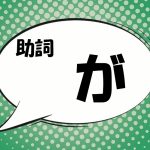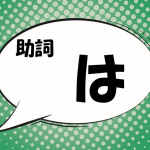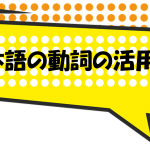
目次
- 1 The basic knowledge about the Japanese verb forms
- 2 Why japanese have different verb forms and when to use these forms
- 3 The Japanese verb forms
- 4 The ru-dropping form
- 5 How to identify regular verb types
- 6 The te connected form / the te form
- 7 The ta connected form / the ta form (past tense)
- 8 You may also like
The basic knowledge about the Japanese verb forms
Japanese verbs have five basic conjugations, which can be called the u form, the i form, the a form, the e form and the o form.
The Japanese form of verbs that ends with the sound u is called the u form. Similarly, the form of verbs ends with the sound i is called the i form. The same rule is applied to all verb forms. That is, Japanese verbs can change their form simply by changing the last vowel of a verb.
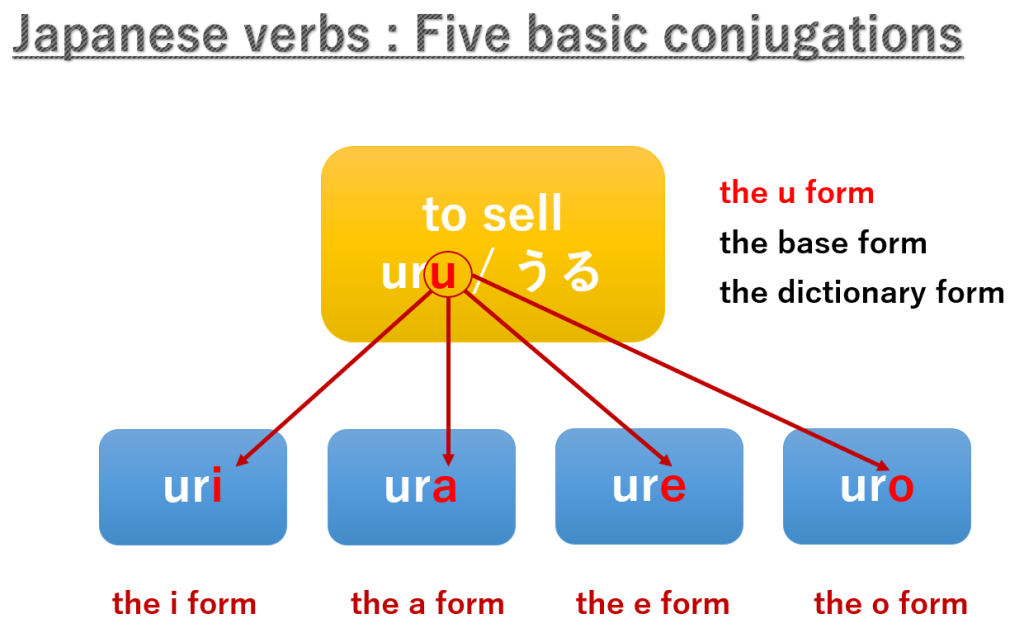
Why japanese have different verb forms and when to use these forms
Japanese verbs change their form to connect with another word like an auxiliary verb or a conjunctive particle.
In English, auxiliary verbs are followed by a verb and the form of the verb is always the base form. In Japanese auxiliary verbs always come after a verb and verbs change their form depending on the auxiliary verb that is placed immediately after the verb.
In Japanese there is a word which is called conjunctive particles. It has similar function as conjunction in English. Conjunctive particles always come after a verb and verbs change their form depending on the conjunctive particle that is placed immediately after the verb.
For example, the i form of verbs is used to the auxiliary verb “masu/ます” which indicates politeness in a sentence. The a form of verbs is used to the auxiliary verb “nai/ない” which indicates negative in a sentence. The e form of verbs is used to the conjunctive verb “ba/ば” which indicates imaginary situations in a sentence. The o form of verbs is use to the auxiliary verb “u/う” which indicates speaker’s will of the action.

The Japanese verb forms
Let’s have a look at five basic verb forms.
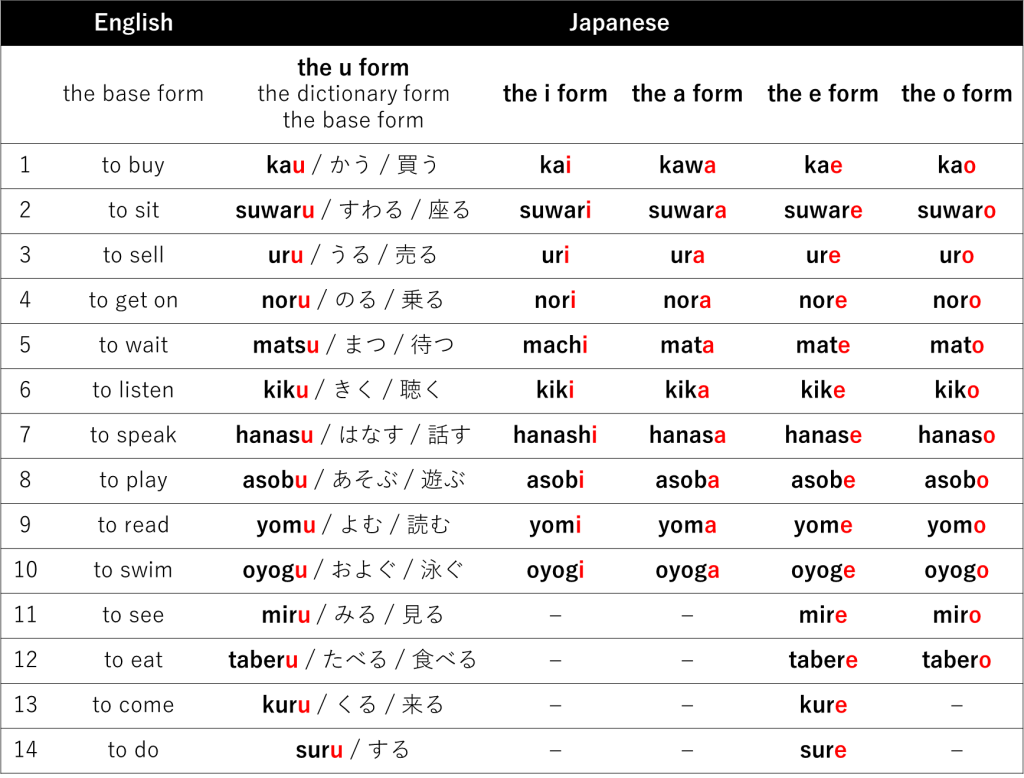
All verbs have the u form because the u form is the most standard verb form. Also all verbs have the e form. Some verbs have all five basic verb forms. You can call them the u regular verb because the only last u of the base form is changed to make another form. Some verbs don't have all five basic verb forms. Only "kuru/くる" which means to come and "suru/する" which means to do don't have the i form, the a form, and the o form. You can call them the irregular verb.
The ru-dropping form
There is an another form called the ru-dropping form. This form is used instead of the i form and the a form of the u regular verbs. The verbs that have the ru-dropping form can be called the ru regular verb.
The irregular verb "kuru/くる" and "suru/する" don't have the ru-dropping form.


The ru-dropping form of the ru regular verbs is used instead of the i form and the a form of the u regular verbs.

For example, the i form of the u regular verbs is used to the auxiliary verb “masu/ます” which indicates politeness in a sentence. Similarly, the ru-dropping form of the ru regular verbs is used to the auxiliary verb "masu/ます."
The o form of the ru regular verbs is not used to connect with auxiliary verbs or conjunctive particles. It is imperative and is used in an imperative sentence.
How to identify regular verb types
There are two types of regular verb and they are the u regular verb and the ru regular verb. All ru regular verbs end with the sound ru. Also irregular verb "kuru/くる" and "suru/する" end with the sound ru. That is, verbs that don't end with the sound ru are all u regular verb.
Verbs that are end with the sound ru can be both u regular verb and ru regular verb. So, you need to memorize type of each verb for them.
All ru regular verbs have i or e sound before the ru, that is all ru regular verbs end with the sound iru or eru. If the final syllables of a verb are iru or eru, however, it is not possible to tell from the verb to which type a verb belongs. This is because some of u regular verbs have the final syllables of iru or eru.
Let's learn type of verbs that are end with the sound ru.
| u regular verb | ||
| Japanese | English | |
| 1 | keru / ける / 蹴る | to kick |
| 2 | kaeru / かえる / 帰る | to go back |
| 3 | shiru / しる / /知る | to know |
| 4 | kiru / きる / 切る | to cut |
| 5 | hashiru / はしる / 走る | to run |
| 6 | hairu / はいる / 入る | to enter |
| 7 | toru / とる / 取る | to take |
| 8 | aru / ある | to be |
| 9 | uru / うる / 売る | to sell |
| 10 | eru / える / 得る | to get |
| 11 | oru / おる / 折る | to fold |
| 12 | karu / かる / 狩る | to hunt |
| 13 | saru / さる / 去る | to go away |
| 14 | chiru / ちる / 散る | to scatter |
| 15 | naru / なる / 為る | to become |
| 16 | nuru / ぬる / 塗る | to paint |
| 17 | furu / ふる / 降る | to fall |
| 18 | heru / へる/ 減る | to decrease |
| 19 | horu / ほる / 掘る | to dig |
| 20 | yaru / やる | to do |
| 21 | waru / わる / 割る | to break |
| ru regular verb | ||
| Japanese | English | |
| 1 | dekiru / できる / 出来る | to be able |
| 2 | iru / いる | to be |
| 3 | hajimeru / はじめる / 始める | to begin |
| 4 | kangaeru / かんがえる / 考える | to think |
| 5 | taberu / たべる / 食べる | to eat |
| 6 | ageru / あげる | to give |
| 7 | miru / みる / 見る | to see |
| 8 | kiru / きる /着る | to wear |
| 9 | hanareru / はなれる / 離れる | to leave |
| 10 | niru / にる / 煮る | to simmer |
| 11 | neru / ねる / 寝る | to sleep |
The te connected form / the te form
The te connected form or the te form is a bit different than the five basic forms of verbs. This form is applied to the verbs that are followed by the conjunctive particle "te/て" which is used to link the auxiliary verb to a verb or to connect two verbs. The te form include the conjunctive particle "te/て" in its form.
How to make the te form of the ru regular verbs
Making the te form of verbs is not easy. You need to memorize the changes.
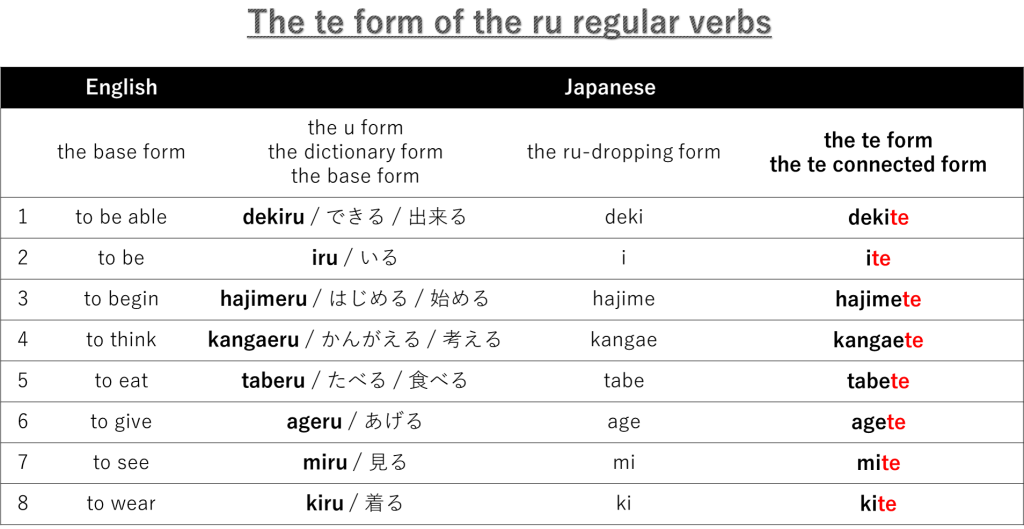
To make the te form of the ru regular verbs, you simply add "te/て" to the verbs in the ru-dropping form.
How to make the te form of the u regular verbs
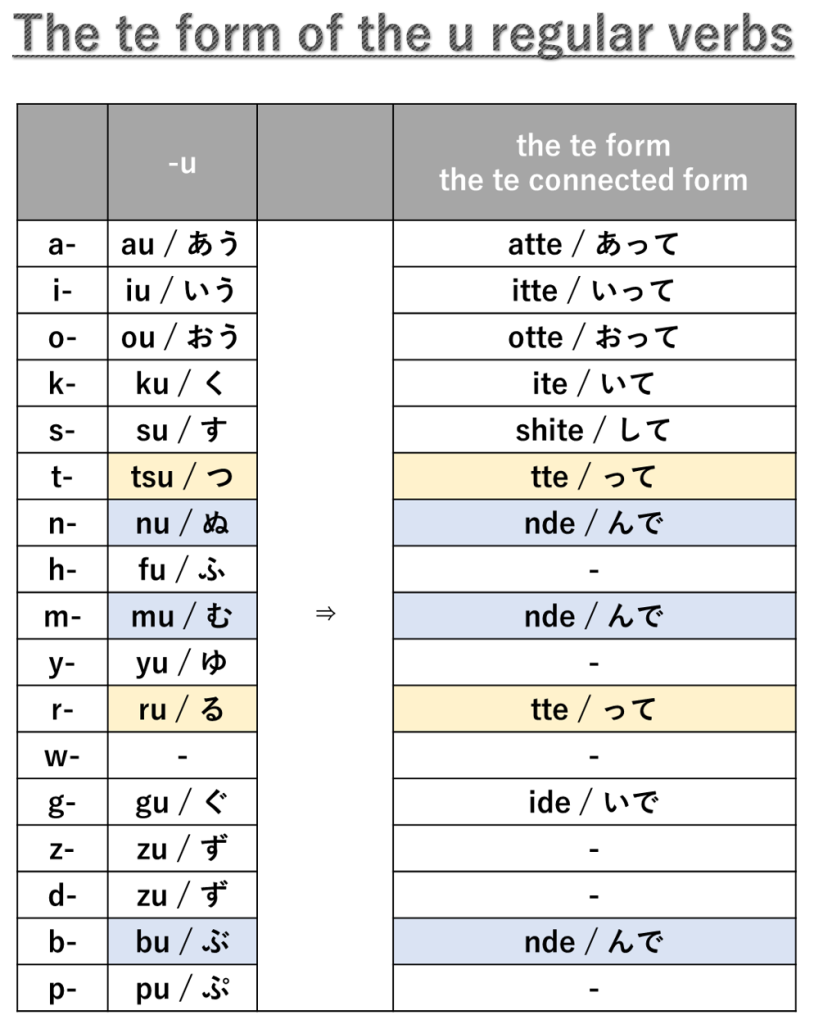
The u regular verbs ending in au/あう, iu/いう or ou/おう, replace the last u with "tte/って."
The u regular verbs ending in tsu/つ or ru/る, replace them with "tte/って."
The u regular verbs ending in nu/ぬ, mu/む or bu/ぶ, replace them with "nde/んて."
The u regular verbs ending in ku/く, replace it with "ite/いて."
The u regular verbs ending in gu/ぐ, replace it with "ide/いで."
The u regular verbs ending in su/す, replace it with "shite/して."
The ta connected form / the ta form (past tense)
The ta connected form or the ta form is really similar to the te form. This form is applied to the verbs that are followed by the auxiliary verb "ta/た" which is used to express events that took place in the past. The ta form include the conjunctive particle "ta/た" in its form.
How to make the ta form of the ru regular verbs
The ta form of verbs is made in the same way as the te form.
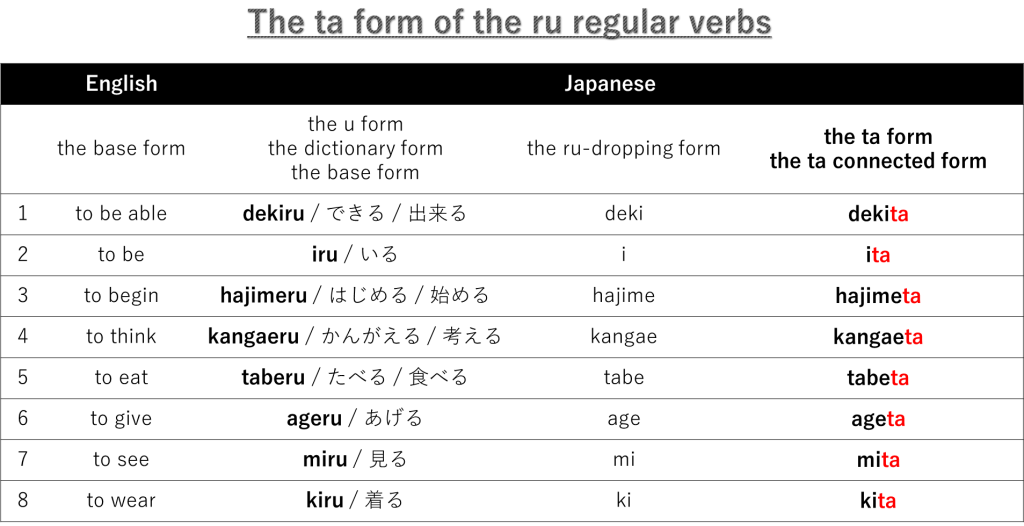
To make the ta form of the ru regular verbs, you simply add "ta/た" to the verbs in the ru-dropping form.
How to make the ta form of the u regular verbs
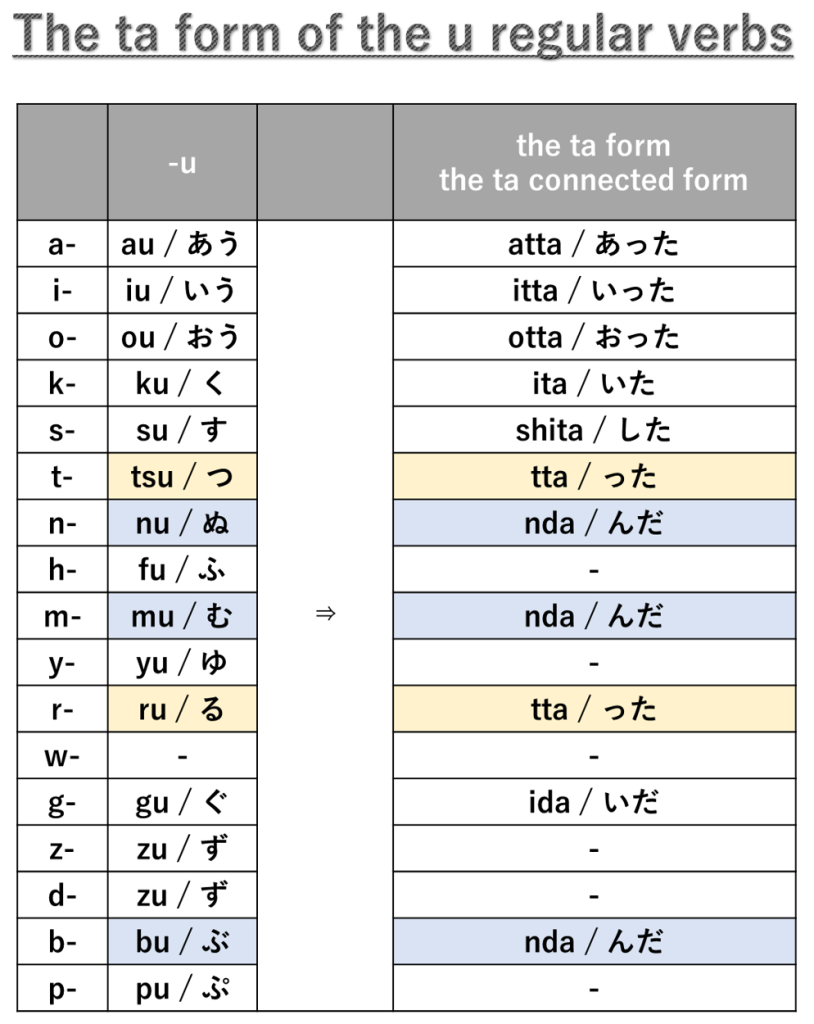
The ru regular verbs ending in au/あう, iu/いう or ou/おう, replace the last u with "tta/った."
The ru regular verbs ending in tsu/つ or ru/る, replace them with "tta/った."
The ru regular verbs ending in nu/ぬ, mu/む or bu/ぶ, replace them with "nda/んだ."
The ru regular verbs ending in ku/く, replace it with "ite/いた."
The ru regular verbs ending in gu/ぐ, replace it with "ida/いだ."
The ru regular verbs ending in su/す, replace it with "shita/した."
You may also like
https://jpgrammar.com/adjective/
